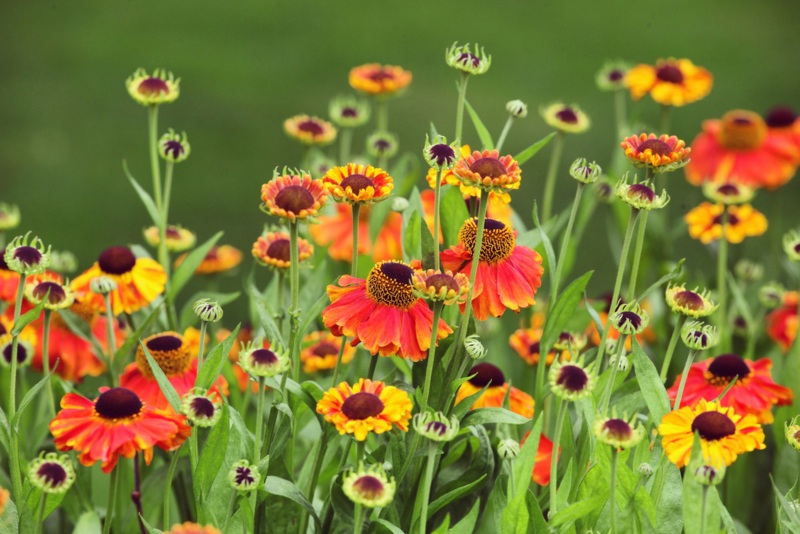
There’s no need to be worried about the name, as sneezeweed definitely won’t make you sneeze. In past times, the dried leaves of this colorful plant were once used to stop an unfortunate bout of sneezing.
Despite its name, sneezeweed or helenium is not a weed at all but a perennial daisy from the Asteraceae family. If you want to set your eyes on its gorgeous blooms, look out around summer to late fall.
Any gardener who wants their garden to attract plenty of bees, butterflies, and other helpful critters ought to plant sneezeweed.
They will add plenty of color to your garden with yellow, red, and sometimes orange shades throughout its petals. You can usually find them in meadows, prairies, and woodlands throughout North America and Canada.
If you’ve ever wondered how to grow and care for sneezeweed, you’re in luck because this guide will provide the most accurate details on the plant. While not everyone loves sneezeweed, perhaps due to its namesake, it’s still one of the more lovely flowers around.
Learn more about growing and caring for sneezeweed, whether you’re a hobby gardener or an expert looking for more information.
| Botanical Name: | Helenium autumnale |
| Common Name(s): | Sneezeweed |
| Plant Type: | Perennial flower |
| Mature Size: | 2–5 feet tall |
| Sun Exposure: | Full sun |
| Water Needs: | Average |
| Soil Type: | Moist, well-drained |
| Soil pH: | 5.5 to 7.0 (acidic) |
| Bloom Time: | Late summer to Fall |
| Maintenance: | Low |
| Flower Color: | Light yellow, orange, red, golden yellow, coppery gold |
| Hardiness Zones: | 6 (USDA) |
| Toxicity: | Toxic to humans and pets |
Light and Temperature
The ideal spot to plant sneezeweed is in an open space with lots of sun. It needs at least six hours of sun each day, so be sure to plant them where there is little to no competition from other plants.

In cases where there isn’t much light, it can be moved to a better location or given at least partial sun for most of the day. Sneezeweed can tolerate scorching weather, particularly during the summer.
Water
Despite its tolerance for dry weather, never allow the soil to dry out as this will result in wilting completely. Ensure that you water your sneezeweed at least twice a week, and you create conditions for the soil to retain maximum moisture.
Take special care to water during hotter and more humid months of the year. During times of little to no rainfall, you should water them daily. Be careful not to use too much water, as sneezeweed will die from overwatering.
Soil
Sneezeweed prefers acidic soil between the PH range of 5.5 to 7.0, so it’s best to do a soil pH test before planting them. Soil should be rich and moisturized or wet yet well-drained. Though this isn’t the first preference, they can do well in certain clay soil types.

Fertilizer
In the case that you do choose to fertilize sneezeweed, use a well-balanced fertilizer, especially one with low nitrogen levels.
High nitrogen can spike the growth of the foliage instead of the flowers. It is best to fertilize this plant during early spring while it is starting to grow. Do not over-fertilize as this plant is not a heavy feeder.
Generally, when planted in fertile soils, they do well and may require just one application of fertilizer.
Are They Toxic?
The question of toxicity in plants is relevant, especially when it comes to the safety of human beings, pets, and livestock.
It is important to note that the leaves, seeds, and flowers are poisonous to humans when ingested in large quantities. It can lead to irritation of the intestines or cause gastric issues, which can quickly become fatal.
Animals that may be affected by the plant are sheep, dogs, horses, and fish.
Propagation
Propagation of sneezeweed is done through the seeds. These can be sown during the springtime and placed in individual pots in a greenhouse during winter.
However, the best method for propagation involves using tip cuttings and planting them during early spring. Propagation can also be done in cooler times and even during autumn in warmer locations.

Deadheading
Extending the life of a flower is something most gardeners would like to achieve. Deadheading sneezeweed will prolong its flowering season, and it may rebloom after pruning.
Apart from making the garden appear tidier, it may help control seed dispersal and improve root growth.
Growing From seed
Sneezeweed seeds may take between 14-21 days to germinate. Plant seeds during spring in an area with well-drained soil and full sunlight.
Place seeds about 2 inches deep before covering and water the soil to retain moisture. Keep watering once weekly until sprouting takes place. Followup by watering twice weekly after emergence.





